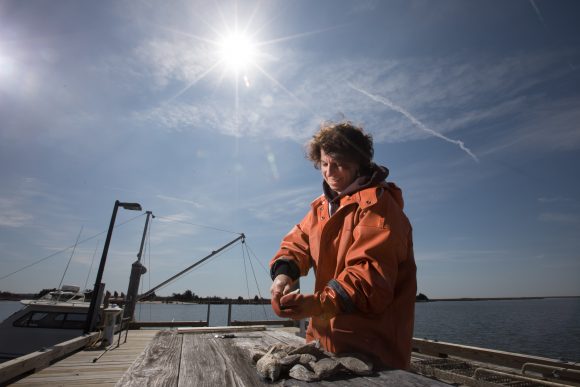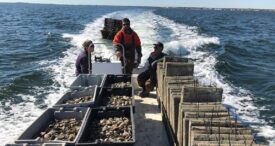Like many sectors in the global economy, the shellfish aquaculture industry has suffered significant economic decline, especially as shellfish farmers rely on direct sales to restaurants or on wholesale markets that ultimately serve restaurants.
As the COVID-19 pandemic shuttered restaurants across the U.S., a critical link in the shellfish aquaculture supply chain was lost. This disruption in demand not only led to diminished farm revenues, but also created significant disruption in management of oyster stock as oysters that were bound for spring and summer harvests remained on the farm for a longer term than anticipated.
While some farmers have had success establishing alternate markets through shucking houses, online sales, and other direct-to-consumer opportunities, sales have still not rebounded to pre-pandemic levels. Fortunately, oysters hold value beyond the raw bar. They are considered beneficial to the environment by serving as habitat for a number of commercially and recreationally important finfish, improving water quality, and sequestering nitrogen and carbon. These ecosystem services are essential to the health of bay environments and underscore oyster habitat enhancement and restoration as a pressing goal worldwide.
In New Jersey, funding from a special NOAA Sea Grant COVID-19 Rapid Response Aquaculture Funding Opportunity allowed for the purchase of 76,000 of these oversized, farm-raised oysters directly from oyster farmers for the purpose of restoring habitats. The grant brought together a collaborative partnership of scientists, Rutgers Cooperative Extension specialists, state resource managers, environmental non-profits, and shellfish farmers with Rutgers University and New Jersey Sea Grant taking the lead alongside partners that include New Jersey Department of Environmental Protection, Stockton University, the Barnegat Bay Partnership, Partnership for the Delaware Estuary, Pew Charitable Trusts, and the New Jersey Aquaculture Association.
The oysters were transplanted from farms to targeted restoration sites in the Little Egg Harbor and Mullica River in September. The overgrown oysters provide an ecological jump start that might otherwise take years to achieve using traditional oyster restoration practices, which rely on shell recycling and natural recruitment of oysters.
Lisa Calvo, aquaculture program coordinator at Rutgers and New Jersey Sea Grant, led the project, which aims to serve as a model for future efforts. The intent is to establish a shellfish exchange that will serve as a broker to link shellfish farmers and restoration practitioners. This approach provides shellfish farmers with the opportunity to diversify their businesses while supporting a sustainable and healthy future for Bayshore ecosystems and economies.
The New Jersey-based project helped to inspire the Supporting Oyster Aquaculture and Restoration (SOAR) initiative that was created in collaboration with pew Charitable Trusts, NOAA, and the USDA. SOAR aims to extend $2 million in payments to oyster farmers over the next two years, support more than 100 shellfish companies, and preserve more than 200 critical jobs in northern New England, the Mid-Atlantic, and the state of Washington.
This article originally appeared in The New Jersey Agricultural Experiment Station 2020 Annual Report which spotlights the many stories of outreach and resilience during COVID-19. To read more, see the NJAES 2020 Annual Report.



